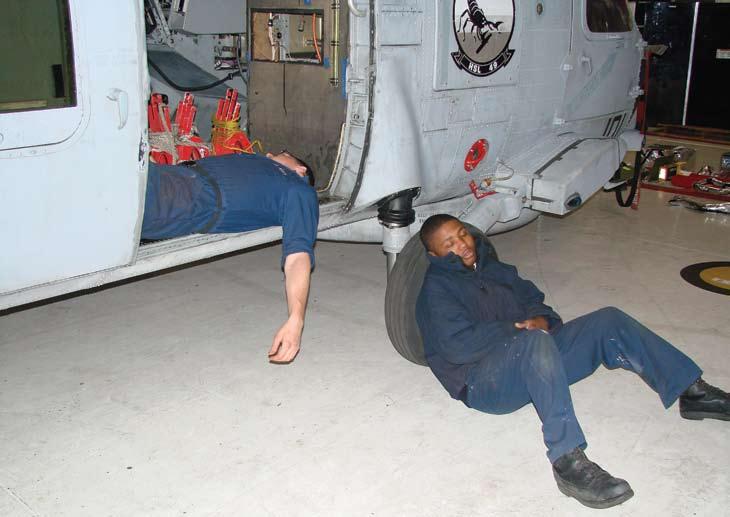
4 minute read
Crew Rest... Not Just for Pilots
By LCdr. Ryan Dunn
If those who fly aircraft are governed by rules that dictate how long their crew day is, why isn’t there a common risk management tool for those who work on aircraft? Should we accept a fatigued aviation machinist’s mate replacing a vital engine part, after working 15 hours straight, just because he or she isn’t flying an aircraft? Should we assume good old deckplate leadership has a firm grasp on what their people are doing and know when to cut them loose when it pushes the safety envelope?
Advertisement
Navy photo by Ltjg. P.J. Perrott, HSL-49 Scorpions public affairs officer
I don’t think so. Inevitably, 100 percent of our leadership doesn’t make the right decisions concerning risk management all of the time. None of us do. So what are the options?
HSL-49 has fought the problem of potential fatigue, associated with maintenance personnel’s extended working hours, by putting an instruction in place that takes risk management to a new level. HSL-49’s commanding officer directed his leadership to come up with a tool that enhances the quality of maintenance and the
CONDITION Work > 12 hours Work > 15 hours Rest < 10 hours Rest < 8 hours
APPROVAL AUTHORITY MO/Det OIC XO MO/Det OIC XO
safety of its personnel by standardizing risk management approval for personnel who work extended hours. The rules are simple and easy to follow—personnel working more than 12 hours require department-head approval. Individuals working more than 15 hours require executive officer’s approval and should only be requested “on very rare occasions.” Not only are we concerned about working hours, but rest in between shifts is just as important. For personnel with less than 10 hours off, the department head must be notified, and permission for personnel to be granted less than eight hours off must be requested from the executive officer.
This instruction forces our leading petty officers, chiefs, division officers, and department heads to make risk decisions at the right levels by taking a closer look at personnel and ensuring they don’t put themselves, aircraft, and aircrew at unnecessary risk. We owe it to our maintainers, aircrew, and aircraft to continually strive for ways to mitigate risks, in order to prevent on- and off-duty mishaps. This tool wraps all four principles of ORM together to effectively prevent those holes in the
Maintainer fatigue is a tough nut to crack and has been ignored far too long. Congratulations to
HSL-49 for taking an important first step toward solving the problem. Here are some additional points to consider as you address maintainer fatigue and strive to maximize your maintenance team’s effectiveness.
If supervisors are to make good decisions regarding work hours, they also must understand fatigue’s effects on performance. Fatigue is four times more likely to contribute to workplace impairment than drugs or alcohol. Are you aware that a typical person’s work performance rapidly declines after about 15 hours of wakefulness? At 18.5 hours, the effects of fatigue may be compared to the effects of a blood-alcohol concentration of 0.05 percent. So, if you’re the XO and have to decide whether to extend work beyond 15 hours, make sure you understand the magnitude of the increasing risk.
It’s a good idea to be familiar with fatigue effects due to working nights, shift work, and circadian rhythms, so that these factors also can enter the decision process. Nights are particularly hazardous because human brains are “programmed” to be awake during the day and asleep at night. This means that people working nights often are struggling to maintain alertness levels that come more naturally during the day. Swiss-cheese model from lining up. It’s working . . . feel free to try it!
LCdr. Dunn is HSL-49 Det. 4 officer in charge.
From the MO:
OPNAVINST 3710.7T, 1 Mar 2004, pg 8-6, para 8.3.2.1.1, under Flight Crew and Flight Support Personnel, states, “Commanders should make available eight hours sleep during every 24-hour period. Schedules will be made with due consideration for watch standing, collateral duties, training, and off-duty activities.”
Definition for “flight support personnel” is “personnel immediately involved in maintenance... of aircraft,” as found on page 32.
Cdr. Bert Ortiz is the Naval Safety Center’s
Aeromedical Feedback
maintenance officer. Supervisors need to consider what time of day to schedule the most difficult maintenance tasks, especially if workers already are fatigued from long hours, sleep deprivation, shifts, or jet lag.
Every member of the maintenance team should understand fatigue and its effects. It does little or no good for a supervisor to cut short a long day, only to have personnel opt to party or do anything else other than sleep. Everyone’s priority should be to get some sleep.
Flight surgeons can be an excellent resource regarding fatigue; they have access to tools that can help you formulate your war on fatigue. With increased awareness of fatigue and its impact on safety, we all can work more safely and effectively. For more information on fatigue and its effects, visit the Naval Safety Center’s Aeromedical division website at: http://www.safetycenter.navy.mil/aviation/aeromedical/default.cfm
There are several links relating to fatigue, including one where you can order a copy of the Aeromedical Fatigue Video CD. Of course, you also can contact us via phone or e-mail.
Cdr. Kevin Brooks is an aeromedical analyst at the Naval Safety Center.










